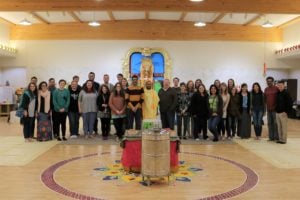![]()

We did nothing profound when we visited the Hindu temple in Bentonville, Arkansas. We simply loved our neighbors and listened to their faith journey explanations.
Twenty-seven John Brown University students visited the Hindu temple at the Hindu Association of Northwest Arkansas on March 4 under the guidance of David Vila, professor of biblical studies, religion and philosophy.
Vila arranged the trip to complement the Introduction to Hinduism and Buddhism class with cultural exposure to Hindu faith. Intro to Hinduism and Buddhism is required by several majors and minors at JBU, giving intercultural exposure and providing a rigorous philosophical account of a different set of beliefs.
While students have different reasons for taking the class, we all benefited by the practical experience of seeing what Vila calls “embodied religion.” The trip to the Hindu temple was a valuable opportunity to meet people who participate in one of the world’s dominant faiths.
Visiting the Hindu temple was mysterious at first because embodied religion – the practical, lived-out expression of faith – has more life and dynamic than can be anticipated.
When we entered the temple, there was prayer in progress by the Pradhana Archaka, the “chief priest,” Venugopalaswamy. He was praying to Krishna. We were initially greeted by Uma, vice president of HANWA. During a question and answer session, he explained the meaning of prayer and Hindu worship.
“In Hinduism, there is not superior and inferior. Plants, animals and people all come from the super-soul Paramatma, from which every being is created. We are all manifestations of the one true God, Paramatma. When we pray to Krishna, we are praying to Vishnu. When we are praying to Vishnu, we are praying to Paramatma. When we pray, we are always praying to that one true God,” said Uma.
After entering, the temple became less ethereal and more concrete as we explored the temple. The main area is devoted to the central worship of Krishna, the most prominent avatar representing Vishnu, a central Hindu god. The back area is a line of images of the Hindu pantheon. In front of these icons are piles of coins devoted in worship of certain gods. Each item or section has purpose. Symbolism is very prevalent in the Hindu faith.
After exploring the temple, three leaders hosted a question and answer session. JBU students posed at least 20 questions about Hindu belief, marriage, understanding of Jesus and temple artifacts.
Gwen Anderson, senior intercultural studies major, visited India and expected a lot from the temple visit.
“I went to India after my high school graduation. I didn’t understand much about the religion or the culture, honestly. I was kind of in the dark the whole time just experiencing culture, but not really knowing what was underlying all of the religious practices or all the gods you see everywhere,” Anderson said.
Anderson compared her past and recent experience in Hindu temples. “In India, there are these big flower markets. Here, they get a bouquet from Walmart. It made me wonder, ‘Are Walmart flowers any less holy than flowers you buy at the Indian market?’”
Anderson encourages the study of worship practices and differences between groups of Hindu believers. “I would read
about what Dr. Vila said is ‘popular piety.’ I would look into different types of Hindus to know what to expect to hear. A lot of what they said was pretty foreign,” Anderson said.
Jack Tyler, junior English and philosophy major, also attended the trip. Tyler recalled answers given to him during a question and answer session with three Hindu temple leaders. “They described themselves as being a Vedic community. But they
also described themselves as being monotheists,” Tyler said. The Vedas are the oldest source of Hindu scripture.
Tyler experienced some of the variety of Hindu worship at the temple. “There’s not just one unified program. One person worshipped this one god and another bowed down to another god. Kids were free to run around. People had different postures doing different things.”
The Hindu leaders welcomed us into their home and knowledgeably answered questions. They even accepted photos because we were respectful and inquisitive.
The Hindu leaders at HANWA welcomed JBU. Anderson described ideas of how we could seek further relationship with those whom we met. “We could invite them to have tea or to speak at JBU.”




